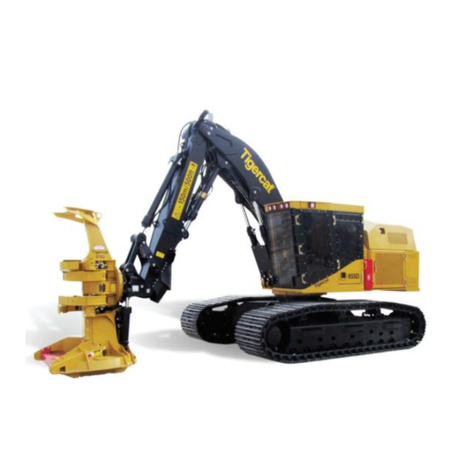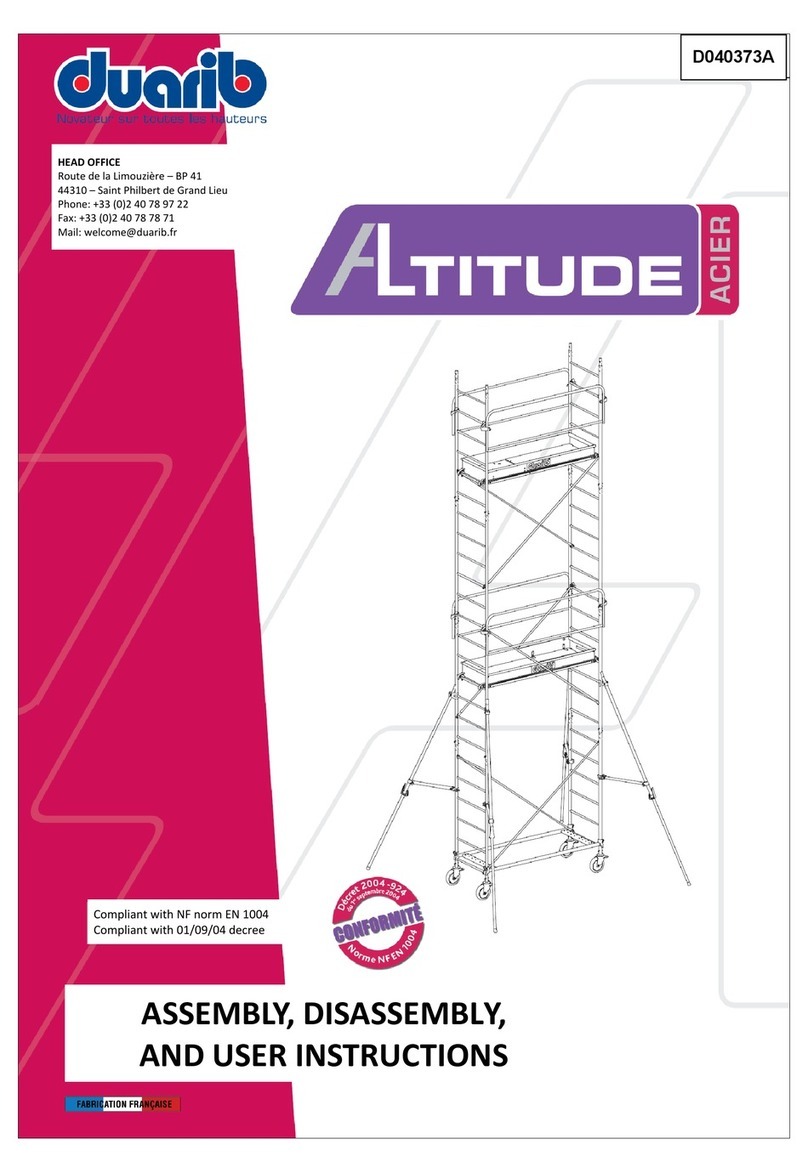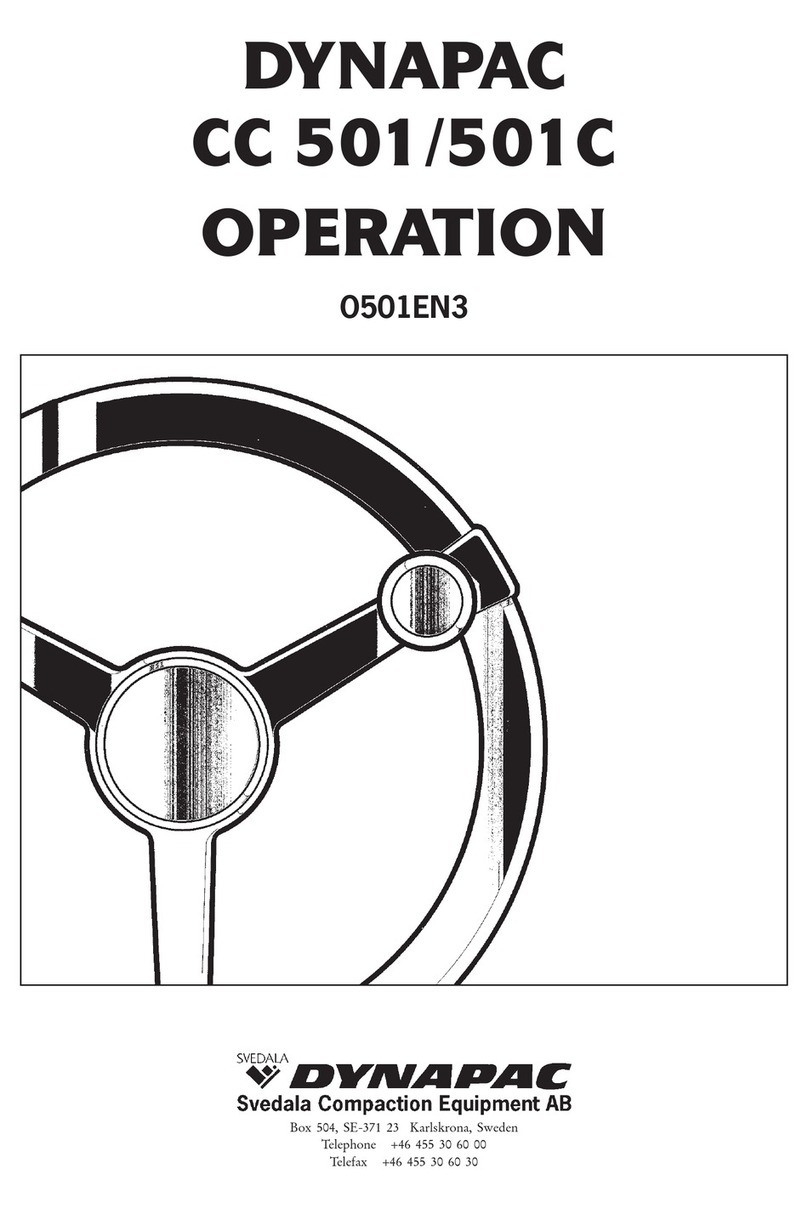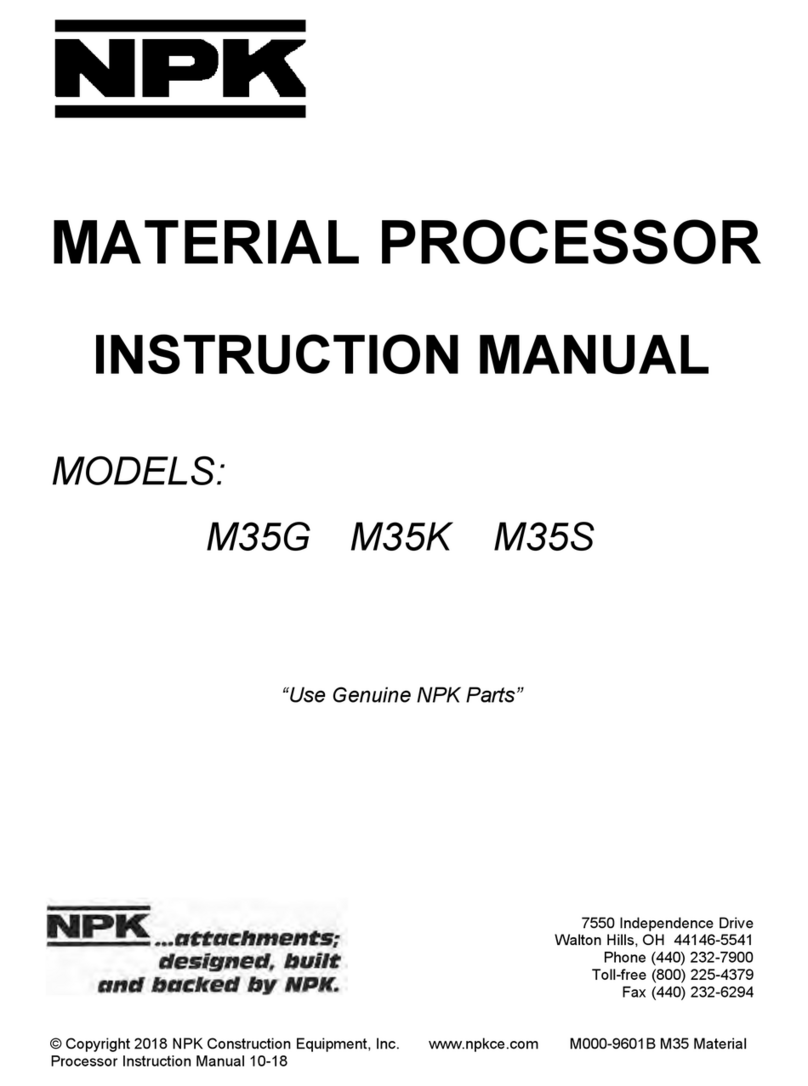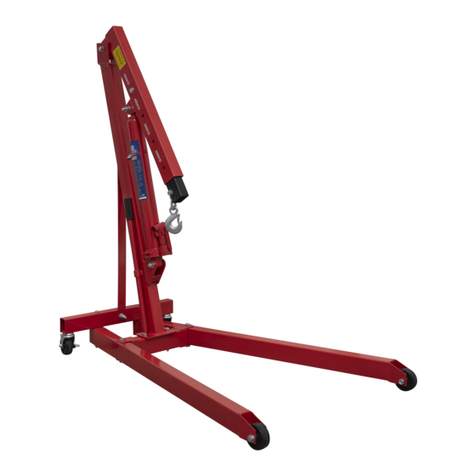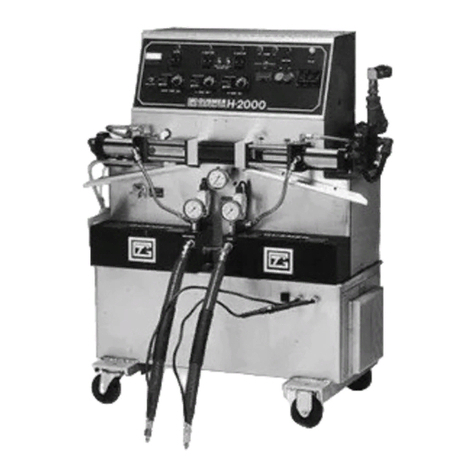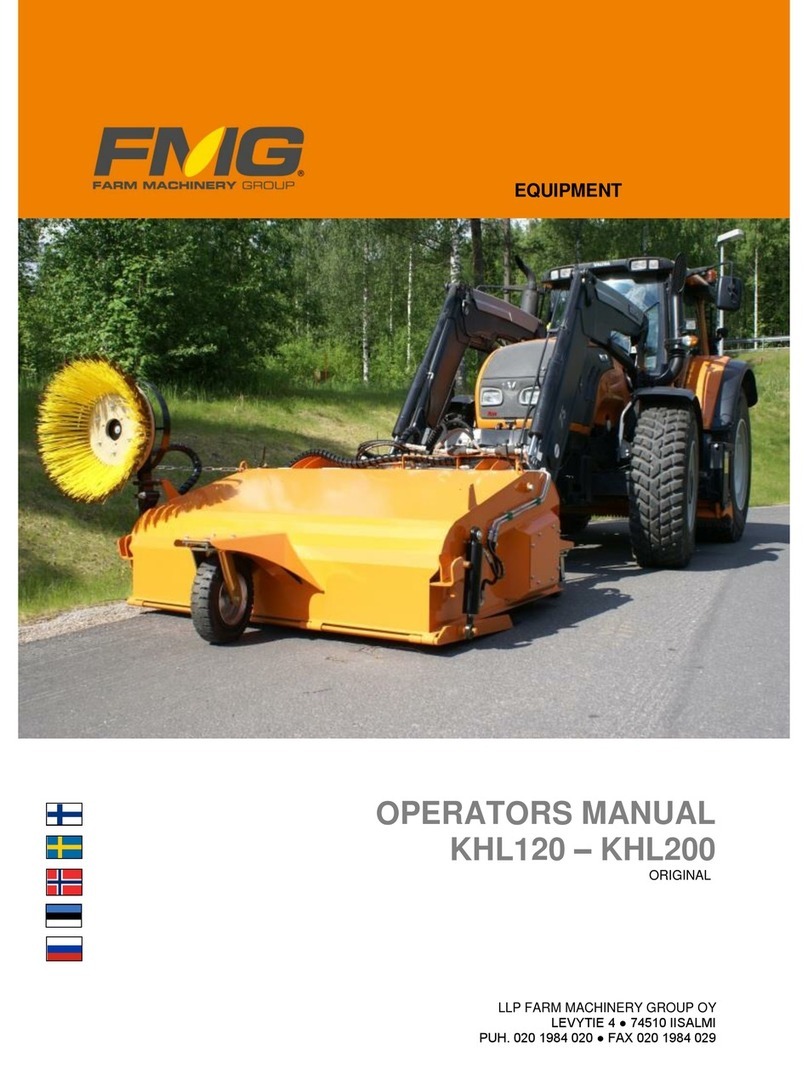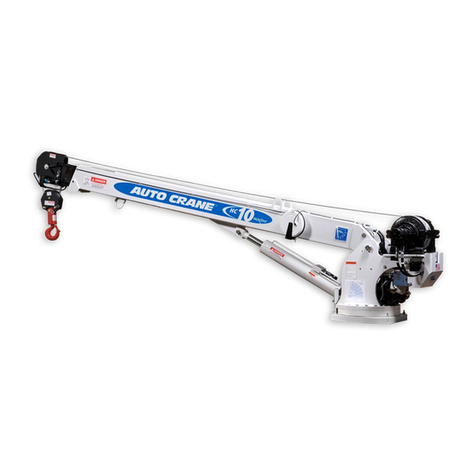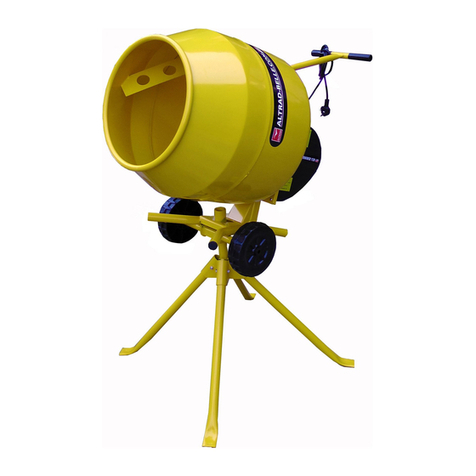Trelawny MHS 5 Troubleshooting guide

MHS 5
MULTI-HEADED SCABBLER
OPERATION & MAINTENANCE

OPERATION
General Information
Thank you for your purchase of the
MHS 5 Multi-headed Scabbler.
Before operating the Scabbler, this
m a nu a l m u st b e r e ad a n d
understood by the operator, if in any
doubt ask your supervisor before
using this equipment. Failure to
follow these instructions could result
in damage to the Scabbler and/or
personal injury.
Trelawny SPT Ltd disclaims all
responsibility for damage to persons
or objects arising as a consequence
of incorrect handling of the tool,
failure to inspect the tool prior to
starting work for damage or other
faults that may influence the
operation or safe working of the tool,
or failure to follow the safety
regulations or applicable to the job
site.
The tool is primarily designed for
concrete reduction, and can be used
for the removal of laitance from
concrete floors, but may also be
used for the removal of heavy paint
or epoxy floor coatings, it can be
used both indoors and out.
Note:
Operators should be familiar with the
data given in the specification
section.
Please keep these instructions in a
safe and accessible place.
This tool must not be used in
potentially explosive atmospheres.
Where a vacuum shroud assembly is
supplied separately, see the
instructions under “Servicing” for
fitting.
ASSEMBLY
Remove 4 x M8 and the 1 x 6mm
screws from the upper handle.
Insert the top handle into the
lower handle and secure with the
4 x M8 Screws.
Attach the hose clip to the upper
handle with the 1 x M6 screw.
Do not over tighten.
Recommended
lubricants
Oil the tool daily before use. Put a
liberal quantity of one of the
following air tool lubricants through
the air inlet.
SHELL Naturelle HF
CASTROL Carelube HTG 22
Cleaning
At intervals of no more than 100
hours use, or if operation becomes
unproductive, or if any of the pistons
shows signs of sticking, dismantle
and clean with highly refined
pa raffin. Replace a ny worn
components as necessary.
I m m e d i a t e l y a f t e r c l e a n i n g ,
thoroughly oil the tool with one of the
recommended lubricants.
Risk of Hand-arm
Vibration injury
These tools may cause Hand-arm
Vibration Syndrome injury if their use
is not adequately managed. We
advise you to carry out a risk
assessment and to implement
measures such as; limiting exposure
time [i.e. actual trigger time, not total
time at work], job rotation, ensuring
the tools are used correctly, ensuring
the tools are maintained according to
our recommendations, and ensuring
that the operators wear personal
p r o t e c t i v e e q u i p m e n t [ P P E ]
particularly gloves and clothing to
keep them warm and dry.
Employers should consider setting
up a progr amme of h ea lth
surv eill a nce to establ ish a
benchmark for each operator and to
detect any early symptoms of
vibration injury.
We are not aware of any PPE that
provides protection against vibration
injury by attenuating vibration
emissions.
See „Specifications‟ section for
vibration emission data.
Further advice is available from our
Technical Department.
ALWAYS DISCONNECT
THE TOOL FROM THE AIR
SUPPLY BEFORE
CARRYING OUT ANY
SERVICING OR
MAINTENANCE
OPERATIONS.
Manual Handling
T h e c o m p l e t e t o o l w e i g h s
approximately 114kg (251.5lbs).
Where possible use a hoist with
correctly rated lifting equipment to
connect to the supplied lifting
eyebolt, which is fitted on the top of
the MHS5 Scabbler.
Ensure that the eyebolt is screwed
down to its shoulder and has been
tightened using a bar no longer than
150mm (6.00”).
Do not use the handle as a lifting
point during any lifting operation.
Always apply local health and safety
regulations with regard to manual
handling.
Safety Precautions
Do wear Personal Protective
Equipment including safety goggles,
footwear, ear defenders and gloves.
In some environments it will be
necessary to wear facemasks or
breathing apparatus.
Do be aware that this tool is not
electrically insulated.
Do ensure that this tool is lubricated
daily.
Do be aware that this tool can create
dust and flying debris.
Do be aware of others working
around you.
Do keep hands and clothing away
from moving parts.
Always observe safe working
practices and local safety
regulations at all times.
Do not allow the tool to run
unattended.
Do not use this tool to prepare walls.
Do not allow the tool to run
continuously whilst not in contact
with the surface being prepared.
Do not modify this tool in any way,
as this will invalidate the warranty
and could lead to serious injury.
Do not use this tool in potentially
explosive environments.
Do not drag this tool by the air hose.
Do not use petrol (gasoline),
thinners or any other high flash point
solvent to clean the tool.
Please note: Unrestrained hoses
can whip if they become detached.
Ensure that the work place is well
ventilated. Avoid operating engine-
powered com pressors in an
enclosed area, since engine exhaust
gases are poisonous.

SERVICING
Safe use of this tool requires a solid
stance and secure foothold; the
operator must adopt a firm and
stable position at all times. To
operate the tool pull the lever on the
handle bar and immediately start to
move the tool back and forth.
Keeping the lever depressed,
continue until the desired finish is
achieved. Never run the tool
continuously in the same place, as
the cutterheads will dig into the
surface.
To switch off,
Simply release the lever on the
handle whilst continuing to move the
tool back and forth. Complete a
small area noting the performance;
stop the tool, inspect the finish
produced. Handled correctly the
MHS 5 Multi-headed Scabbler will
work quickly and efficiently.
Gloves and personal protective
equipment must be worn when
using this tool. The tool will ride
irregularities of up to 13mm (1/2”).
Anything greater will risk cutterhead
damage.
Care must be taken to avoid
damaging or tripping over the air
hose.
Servicing
Only a competent person, in a
suitably equipped workshop, must
carry out maintenance.
Always disconnect the tool from
the air supply before carrying out
any of the following operations.
Dismantling
After ensuring that the air supply is
turned off, remove the tool from the
airline. Thoroughly clean the outside
of the tool prior to dismantling.
Scabbler Head Removal
Remove the eyebolt (7) from the
block (1). Take extreme care against
trapping your fingers when lifting or
turning the tool over, Using the
handle, pull the tool over until it
rests on the handle bars and the
cylinder block top face; remove the
supplied punch (33) from the left
hand side handle bar by removing
the “blanking cap” part of the punch
with a small screw driver.
Follow next section if vacuum shroud
is fitted, then continue with:-
Using a medium hammer and the
supplied punch knock out the spiral
roll pin (14) from each cutterhead
(10).
Remove the cutterhead from the
piston, in some extreme cases it
may be necessary to warm the
cutterhead to ease removal from the
piston, especially if they have been
in situ for some time.
Exhaust Chamber & Vacuum
shroud removal
Remove the plastic caps protecting
the caphead bolts, unscrew the 5 x
bolts using a short extension and
8mm Allen key socket.
Remove the vacuum shroud (3) if
fitted and the exhaust chamber (2)
and clean out any dust that may
have accumulated inside the
chamber.
It is wise to replace the cylinder dust
seals (4) which are situated in
recesses in the exhaust chamber
and also replace if fitted, the rear
vacuum shroud seal (5) at this point
also.
Piston and Cylinder removal
Start with unscrewing the two outer
of the front three cylinders (9) using
a 54mm or 1 1/4” Witworth spanner,
followed by one of the back row and
then the centre front.
The cylinders are retained using a
thread locking adhesive and may
require a sharp blow on the spanner
to break the bond.
Once the cylinders have been
removed from the block (1), remove
the piston (8) from its cylinder.
Remove the wiper seal (13) from is
recess using a small screw driver
and remove both of the cylinders
O‟Rings (12) & (11). Inspect both the
piston and cylinder for any sign of
wear or grooving paying particular
attention to the small bore of the
cylinder. Replace the piston,
pushing it to the bottom of the
cylinder bore, if there is excessive
play between the piston and
cylinder, the cylinder and possibly
the piston will require replacing.
Pre-Start Check
The compressed air supply must be
free from water and dirt. The
installation of a filter/regulator/
lubricator air preparation set (with
moisture trap) adjacent to the tool is
strongly recommended. Always
clear the air hose before connection
to the tool. Ensure that no moisture
(condensation) is present in the air
hose. Ensure that a minimum 19mm
(3/4”) bore air hose is used and that
all couplings are secure; leak free
and in good condition. Limit the
length of air hose to 15M (50ft).
Where extra length is necessary, for
each additional 15M (50ft) of air
hose used, the pressure drop is
approximately 0.16bar (3psi).
Correct operating pressure is
6.2bar (90 psi).
Do not let the operating pressure fall
below 5.5bar (80p.s.i.) or rise above
6.9bar (100 psi) absolute maximum.
Preferably, the compressor should
be able to supply a minimum of
57L/s (120cfm) of free air.
Some compressor manufactures
give a displaced air figure which
generally produces a much lower air
output.
In particularly cold weather it is
recommended that a proprietary anti
-freeze lubricating oil be used.
Starting Work
Prior to operating the tool check: -
That all fittings are secure, free from
leaks and air hoses are in good
condition.
That all parts of the tool are fully
screwed together and secure, if
in any doubt ask your supervisor
before using this equipment.
That a liberal amount of lubricant
has been put into the air inlet of
the tool. (See recommended
lubricants)
Adjust the handle bar to a
comfortable working height for the
operator by slackening off the 4 x M8
caphead bolts on the handle bar
caps, and the single M8 caphead
bolt on the handle bar side quadrant.
Note that the handle bar will be
slightly lower when the tool is in use.
Adjust and retighten all bolts.

and (42). Using a 6mm punch,
drive out the throttle lever pivot pin
and withdraw the throttle lever (36).
ASSEMBLY
Assembly is generally the reverse of
dismantling. Before any assembly
takes place, ensure all internal parts
are clean and have a film of air tool
oil lubrication unless otherwise state.
Avoid lubricating oil or grease
contaminating the threads of the
cylinder (9) and the corresponding
t h r e a d s i n t h e b l o c k ( 1 ) .
These will require securing with a
t h r e a d - l o c k i n g a d h e s i v e .
Replace any parts that show signs of
wear. If the tool is being fully
serviced it is recommended to
change the 8 x vibro-mount vibration
reducing bushes (28), the
8 x Isolastic bushes (16) and all of
the O‟Rings (4), (11), (12), (34), (41)
and (42). It is also good practice to
replace the M10 nyloc nuts during
assembly.
Valve Body Removal/Servicing
Apply general-purpose bearing
grease to the valve stem 39). Insert
valve stem with its O'Rings (41) and
(42) into the valve guide hole in the
valve body, followed by the spring
(40). Screw in the valve cap (38) by
hand and using a 30mm spanner
fully tighten. Using a 6mm punch
align the hole in the valve body (35)
with the holes in the throttle lever
(36). Using a small hammer fit the
throttle lever pin (7).
Piston and Cylinder Assembly.
Fit new wiper seals (13) and new
O'Rings (11) and (12) to the
appropriate small and large grooves
on the cylinders (9).
Insert a piston (8) into each cylinder,
ensure that the piston moves freely
and does not stick or is tight at any
point in the bore.
Fit the scabbler head (10 until it butts
up against the front face of the
piston (8).
Align the holes in the piston (8) with
the Scabbler head (10). The shank
of a new 12.5mm drill bit or
7/16
”
Allen Key is a good fit for this
purpose or use a suitable piece of
dowelling.
Support the scabbler head on a
stable surface. Holding the spiral pin
(14) with a pair of pliers to avoid
hitting the fingers. Using a medium
size hammer, drive in the spiral pin
until central in the scabbler head
(10).
Ensure that the threads of the
cylinder and body (18) are clean and
free of oil; apply a bead of Loctite
243 or similar to the first few threads
of the cylinder.
P u t a l i b e r a l a m o u n t o f
recommended lubricating oil on top
of each piston.
The sequence of replacing the
cylinders are:-
Starting with the central front
cylinder. Screw in the cylinder by
hand and complete the procedure on
each cylinder assembly one at a
time, tighten to a recommended
torque of 135Nm (100 lbs/ft) using a
suitable crowfoot wrench on the
spanner flats. Followed by the back
cylinders, and finally the two outer
front cylinders.
Assembly of Exhaust Chamber
/Vacuum Shroud
Place the block (1) on to its top face.
Check that the cylinder seals (4)
have been fitted into the recesses in
the exhaust chamber and that all the
cutterhead retaining pins (14) are
central, otherwise the exhaust
chamber seals could become
damaged.
Apply a small amount of grease
around the outside of all the
cylinders to help the seals (4) slide
over. Lower the exhaust chamber (2)
into position with the exhaust
chambers cavity nearest the block.
Apply a bead of Loctite 243 or
similar to the first few threads. Insert
the 5 x 10mm caphead bolts
through the vacuum shroud and/or
exhaust chamber and into cylinder
block (1), with a 8mm Allen socket.
Tighten to 80 Nm (60lb/ft.)
Sub-frame to Cylinder Block
Fit new Isolastic anti-vibration
bushes (16) into the block (1) and
tighten by hand. Align the mounting
holes in the sub-frame (20) with the
holes in the block.
Secure using 8 x M10 Nyloc nuts.
Tighten down to a torque of 54Nm
(40lbs/ft)
SERVICING continued
Removing Sub-Frame from
Cylinder Block
With the tool in an upright position,
disconnect the air hose (48) from the
adaptor 15) at the cylinder block.
Unscrew the M6 bolt retaining the
hose clip 31) on the side of the main
handle (21/22). Unscrew the 4 x M8
retaining bolts from the mid section
of the main handle using a 13mm
spanner.
Using the remaining section of
handle (21) pull the tool onto its front
face.
Check that both wheels (25) spin
freely and that the bearings feel
smooth and that there is no
excessive play. If they show signs of
excessive play or if the tyre tread is
badly worn replace by knocking out
the spiral retaining pins with a pin
punch to remove the wheels.
Removal of Handle from Sub-
Frame
Unscrew the 4 x 10mm bolts using
two 17mm (11/16”AF) spanners.
Check that the vibration reducing
vibro-mount bushes (28) are in good
condition, replace if there are signs
of deterioration either from the vibro-
mount bushes from cracking or
perishing.
Only use Trelawny manufactured
vibro-mount bushes, otherwise an
increase in the vibration emission
may occur.
Remove the 8 x M10 Nyloc nuts
securing the sub-frame to the
Isolastic bushes using a 17mm
spanner.
Valve Body Removal/Servicing
Remove the valve body (35) from
the handle (23) if required.
Disconnect the air hose (48) from
the valve body and unscrew the
v a l v e b o d y f r o m t h e
T-connector (46).
If removed, secure the valve body
assembly in a vice, holding on the
main body.
Using a 30mm spanner unscrew the
valve cap (38) from the valve body,
remove the spring (40) and retrieve
the valve stem (39) with its O‟Rings

Trouble Shooting
SERVICING continued
FAULT CAUSE ACTION
Tool bounces in use Air pressure to high. Ensure that the air pressure is set at 90psi. (6.2bar).
Tool performance
slow
Worn Cutter Heads Replace Cutter Heads (Cutter Head life is approximately 100hrs)
Tool drags on floor Insufficient air supply Ensure that the compressor can supply at least 57L/s (100cfm) of free
air at 90psi in order to avoid air supply problems. See also Pre-Start
Check section
Hose bore too small Ensure that the hose bore is 3/4” (19mm).
Hose run too long Each 50 ft. (15 mtrs) of airline used, may drop the pressure by a 3psi.
Worn Pistons and/or
cylinders.
Replace piston and cylinders
If problem has not been cured by any of the above actions, contact your local dealership or agent for assistance.
Long period storage: over
3months
Clean outside of tool, inspect the
scabbler heads for wear; replace any
worn parts as required.
Remove any build up of material
from the cutter head area.
Insert a liberal quantity of air tool oil
through the air inlet and briefly run to
ensure that internal components are
coated with oil. Lubricate the
exposed part of the piston and
cylinder. (See reco mm ended
lubricants)
Cover the tool to protect it.
Store the tool in a dry place.
After 6 months have elapsed, check
the condition of the hose then insert
a liberal quantity of air tool oil into
the air inlet as previously described
and briefly run to ensure that internal
components are coated with oil.
Prior to using the tool again check
the condition of the hose (48) and
the isolastic mountings (16) and the
vibro-mountings (28) for signs of
perishing etc, replace if suspect.
When next used, continue as per
“Pre-Start Check” section.
Disposal
Dismantle into component form for
disposal according to material
composition and dispose of using
waste recycling processes specified
by local regulations.
Note: Flammable material such as
plastic, rubber or composite
materials must not be incinerated but
should be disposed of using normal
industrial waste disposal processes.
Wheel to Sub-Frame
Grease the wheel bearings with a
general purpose bearing grease. Fit
a wheel spacer (26) on to the axle
spindle, followed by a wheel (25)
and a second wheel spacer, and
secure with a spiral pin (14). Repeat
for the other wheel.
Handle to Sub-Frame
Prior to refitting the lower handle
(21) to the sub-frame check the vibro
-mountings (28) for any signs of
deterioration, replace all of the
mountings if one shows signs of
deterioration.
Tool Storage
Short period storage: up to
3months.
Clean the outside of the tool and
inspect the cutter heads for wear,
replace any worn parts as required.
Remove any build up of material
from the cutter head area.
Insert a liberal quantity of air tool oil
through the air inlet and run briefly to
ensure that internal components are
coated with oil. (See recommended
lubricants)
Cover the tool to protect it.
Store the tool in a dry place.

Consumables
5 731.5059 Rear Vacuum Shroud Seal
10 426.5359 TCT Bush Cutterhead
14 813.1050 Roll Pin
SERVICING continued
Exploded View 1
SEE PAGE (10) FOR LIST OF ALL COMPONENTS

SERVICING continued
Exploded View 2

Item No Part No Description
1 611.5050 Block
2 654.5050 Exhaust Chamber
3 652.5050 Vacuum Shroud
4 726.5050 Exhaust Chamber Seal
5 731.5059 Vacuum Shroud Seal
6 818.0750 3/4” Blanking Plug (Block)
7 831.4120 Eye Bolt
8 612.5005 Piston
9 613.5001 Cylinder (O‟Ring grooves used for item 11 & 12 were removed after 2012)
10 426.5359 TCT Cutterhead (Bush) five point
426.5369 TCT Cutterhead (Bush) nine point
11 809.6599 O‟Ring Cylinder (Small) (No longer used after 2012)
12 809.6619 O‟Ring Cylinder (Large) (No longer used after 2012)
13 829.5001 Wiper Seal
14 813.1050 Roll Pin (Cutterhead Retaining)
15 826.5004 3/4” Adapter (Block & Valve body)
16 830.5050 Isolastic Bushes (Block to Sub-frame)
17-19 Not assigned
20 440.5050 Sub-Frame
21 422.5050 Lower Handle
22 422.5055 Top Handle
23 422.5060 Handle Bar
24 422.5065 Handle Bar Clamp
25 833.5050 Wheel
26 655.5050 Wheel Spacer
27 813.0645 Roll Pin (Wheel Retaining)
28 830.1000 Vibro-mount bushes (Sub-frame to Lower Handle)
29 620.5050 Insert (Vibro-mount bushes)
30 617.5050 Washer (Vibro-mount bushes)
31 815.5050 P-Clip (Hose Retaining)
32 822.2000 Rubber Grip
33 633.5050 Pin Punch
34 809.6165 O‟Ring (Punch)
35 422.5005 Valve Body
36 649.5011 Lever
37 665.5011 Lever Guard
38 634.5011 Valve Cap
39 618.5025 Valve Stem
40 712.5001 Valve Spring
41 809.5599 O‟Ring (Valve Seat)
42 809.0069 O‟Ring (Valve Stem)
43 813.0636 Roll Pin (Lever)
44 625.5011 Locknut
45 843.0765 Claw Coupling
46 819.2380 T - Connector
47 342.HY13 90oElbow Connector
48 719.5050 Armoured Hose
831.0620 M6 x 20 Hexagon Head Screw (Vacuum Skirt)
831.0616 M6 x 16 Hexagon Head Screw (Hose Clip)
824.0600 M6 Nyloc Nut
812.2060 M6 Large Washer (Vacuum Skirt)
852.0812 M8 x Button Head Screw (Lever Guard)
831.0825 M8 x 25 Hexagon Headed Screw (Lower /Upper Handle)
806.0830 M8 x 30 Caphead Bolt (Handle bar clamp/Quadrant)
806.1040 M10 x 40 Caphead Bolt
831.1080 M10 x 80 Caphead Bolt
824.1000 M10 Nyloc Nut
812.0710 M10 Plain Washer
PART NUMBER LIST

Trelawny SPT Ltd
Trelawny House, 13 Highdown Road, Sydenham Industrial Estate, Leamington Spa, Warwickshire,
CV31 1XT, United Kingdom
Telephone: +44 (0)1926 883781, Fax: +44 (0)1926 450352, Email: sales@trelawny.co.uk
Website: www.trelawnyspt.com
© TSPT UK 2009 Part No: 735.5050 issue 2
SURFACE PREPARATION TECHNOLOGY
Technical Specifications
Height overhaul / working height Block 970 (38.18”) / 300 (11.81”)
Width at handle bar / Block width 720 (28.34”) / 346 (13.62”)
Length 110 (43.3”)
Blows per minute 1300 x 5
Air consumption 38.0 l/s (80.0 cfm)
Working height 940mm (37.0”)
Tool Weight 114kg (251.5lbs)
Air hose bore - (Inlet Coupling 3/4" BSP claw) 19mm (0.75”)
Removal rate * 30m 2/hr (323ft 2/hr)
Depth of cut (Average)* 3.0mm (1/8””), dependent on operator
Cutting Width 290mm (11.4”)
Closest cut to wall 25 (.98”)
Noise LPA SPL 94.7 dB (A)
Vibration (AEQ)** (Primary hand position) 16.5m/s2(K= +40% -0%)
Vibration (AEQ)** (Secondary hand position) 23.1m/s2(K= +40% -0%)
Trelawny SPT Ltd operates a policy of continuous product development and refinement and therefore reserves the right
to change technical specifications and product designs without giving prior notice.
*These values are guidelines only. Test concrete surface was at least 20 year old.
**The readings given in the above table for the MHS5 Scabbler is carried out on 40N concrete.
Declared vibration emission values are in accordance with BS EN 12096: 1997
(K) Equals the factor of uncertainty, which allows for variations in measurement and production.
Vibration data figures are tri-axial, which gives total vibration emission.
Risk of Hand Arm Injury
Because of various factors, the range of vibration emission during intended use of this tool is expected to be between 23.1m/s2–
32.34m/s2.
The vibration is dependent on the task, the operators grip, and feed force employed etc.
Noise level measured in accordance with EN ISO 15744: 1999
Vibration measured in accordance with BS EN ISO 8662 Parts 1 & 14
BS EN ISO 5349-1: 2001
BS EN ISO 5349-2: 2002
Noise and Vibration Declaration Statement
This tool has been designed and produced in accordance with the following directives:
2006/42/EC Machinery Directive
and applicable harmonised standard: EN ISO 1 1148-4:2010
If your company has any problem with our products or would like to discuss the possibility of an improvement being made to them, then
please do not hesitate to contact us. Your comments are both important and appreciated.
Machinery Directive Information
SERVICING continued
Table of contents
Popular Construction Equipment manuals by other brands
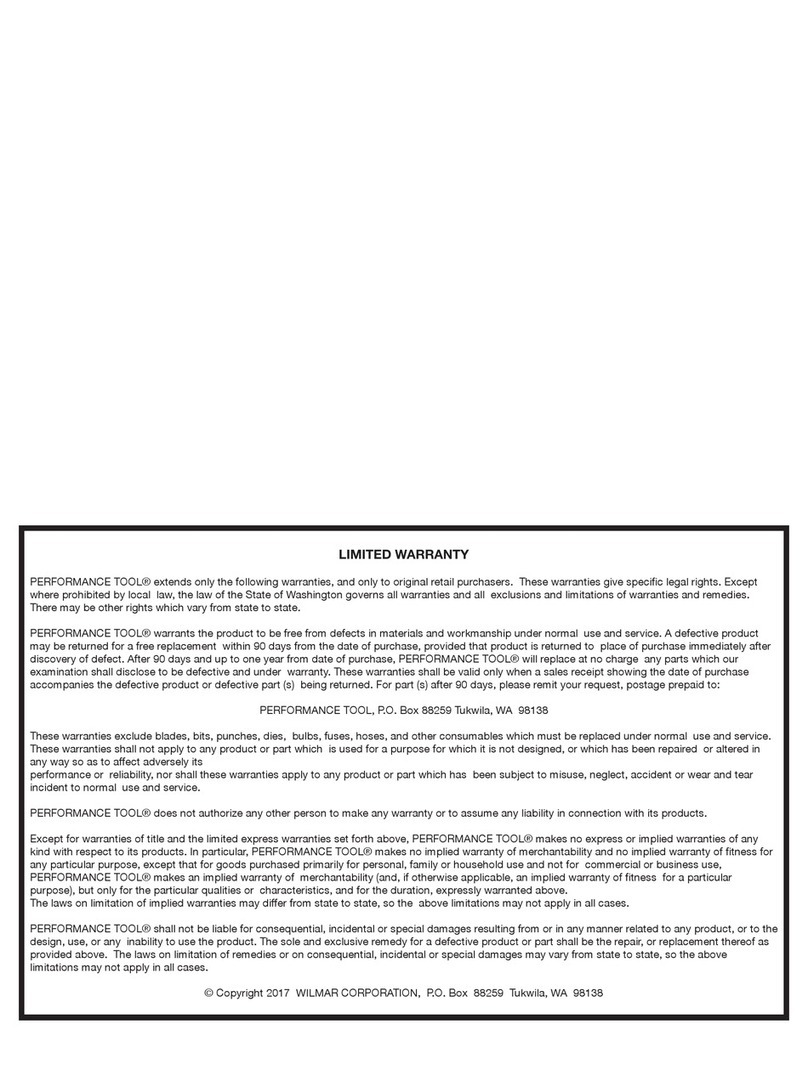
Performance Tool
Performance Tool W41029 owner's manual
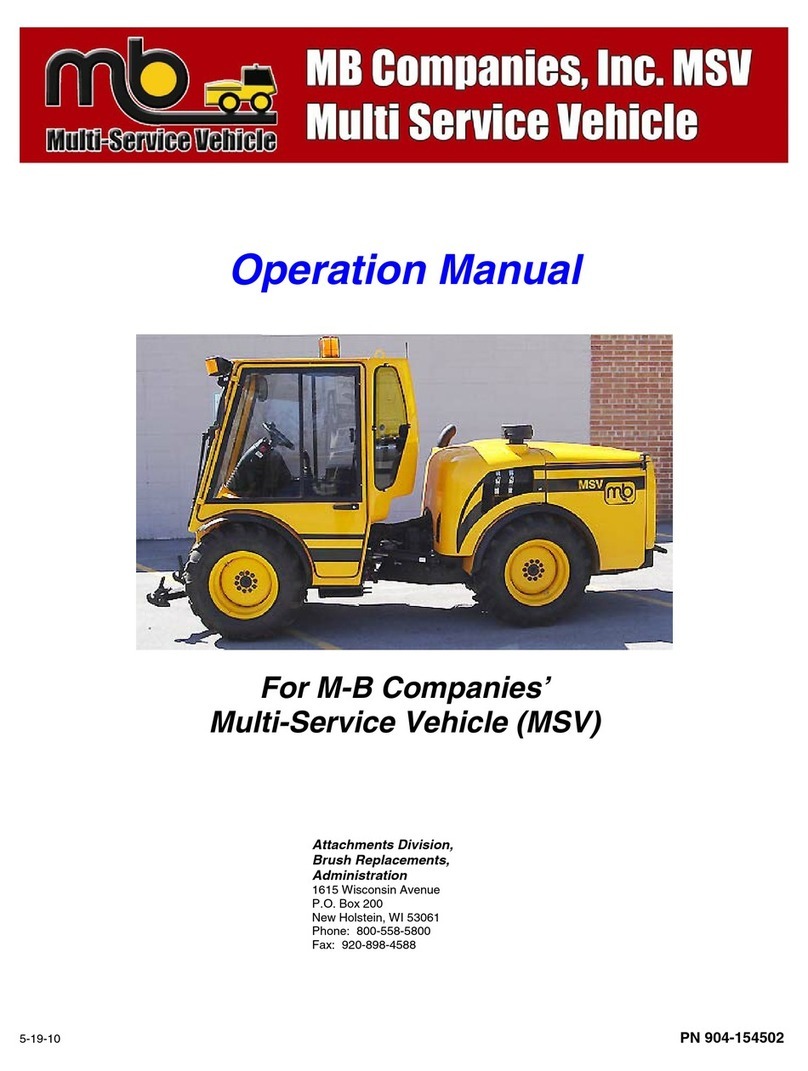
MB
MB Multi-Service Vehicle Operation manual
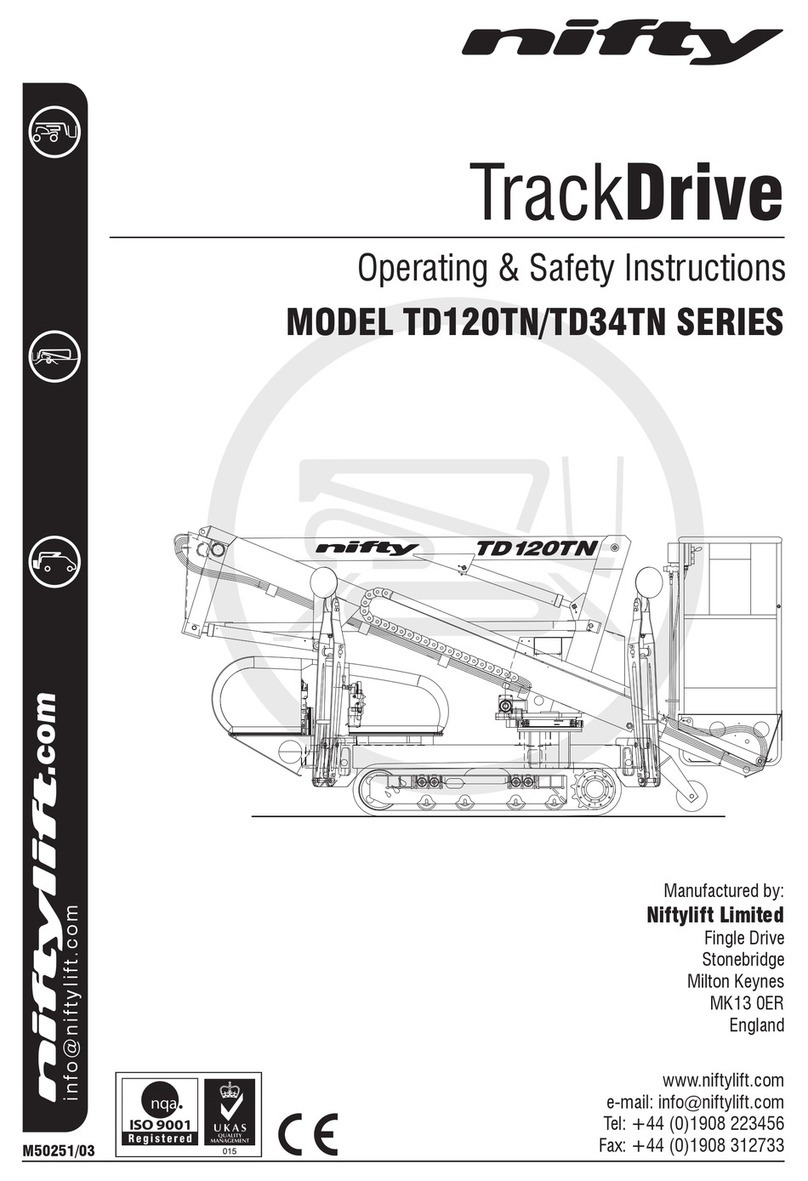
NIFTYLIFT
NIFTYLIFT TrackDrive TD120TN Series Operating/safety instructions

E-Z DRILL
E-Z DRILL 110B maintenance
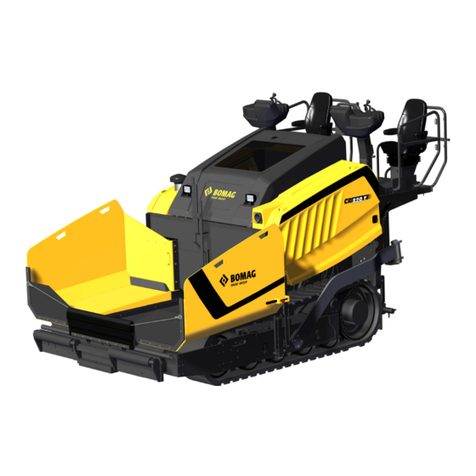
Fayat
Fayat Bomag CR 820 T Tier 4 Operating instructions, maintenance instructions
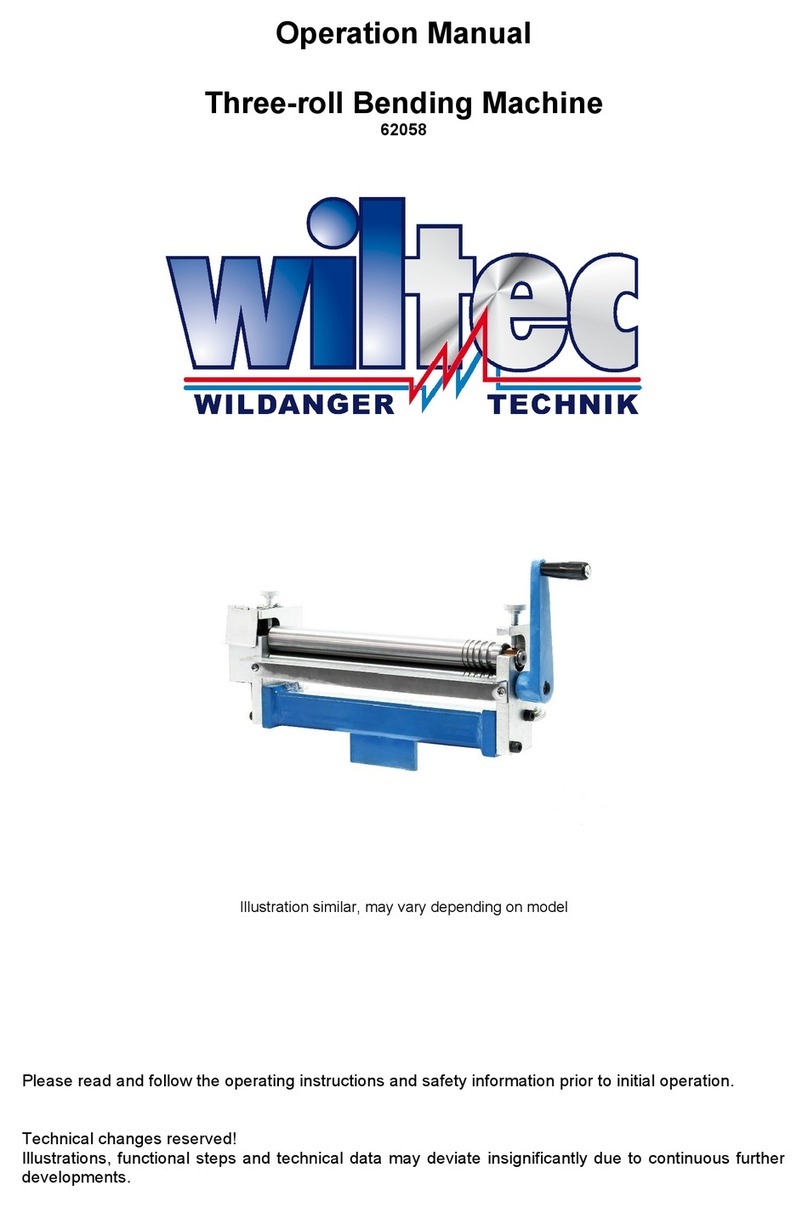
WilTec
WilTec 62058 Operation manual
